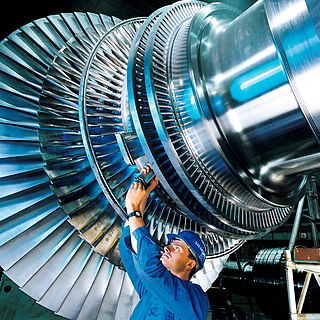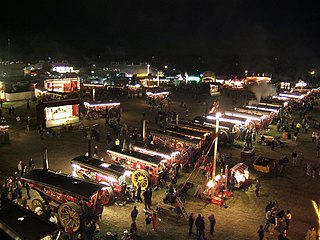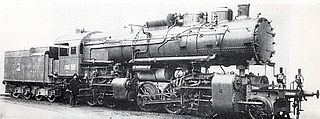
A steam turbine or steam turbine engine is a machine or heat engine that extracts thermal energy from pressurized steam and uses it to do mechanical work on a rotating output shaft. Its modern manifestation was invented by Charles Parsons in 1884. Fabrication of a modern steam turbine involves advanced metalwork to form high-grade steel alloys into precision parts using technologies that first became available in the 20th century; continued advances in durability and efficiency of steam turbines remains central to the energy economics of the 21st century.

A machine is a physical system that uses power to apply forces and control movement to perform an action. The term is commonly applied to artificial devices, such as those employing engines or motors, but also to natural biological macromolecules, such as molecular machines. Machines can be driven by animals and people, by natural forces such as wind and water, and by chemical, thermal, or electrical power, and include a system of mechanisms that shape the actuator input to achieve a specific application of output forces and movement. They can also include computers and sensors that monitor performance and plan movement, often called mechanical systems.

A flywheel is a mechanical device that uses the conservation of angular momentum to store rotational energy, a form of kinetic energy proportional to the product of its moment of inertia and the square of its rotational speed. In particular, assuming the flywheel's moment of inertia is constant then the stored (rotational) energy is directly associated with the square of its rotational speed.
The UIC classification of locomotive axle arrangements, sometimes known as the German classification or German system, describes the wheel arrangement of locomotives, multiple units and trams. It is used in much of the world, notable exceptions being the United Kingdom and North America.

A governor, or speed limiter or controller, is a device used to measure and regulate the speed of a machine, such as an engine.

Rotisserie, also known as spit-roasting, is a style of roasting where meat is skewered on a spit – a long, solid rod used to hold food while it is being cooked over a fire in a fireplace or over a campfire, or roasted in an oven. This method is generally used for cooking large joints of meat or entire animals, such as pigs or turkeys. The rotation cooks the meat evenly in its own juices and allows easy access for continuous basting.
Steam power developed slowly over a period of several hundred years, progressing through expensive and fairly limited devices in the early 17th century, to useful pumps for mining in 1700, and then to Watt's improved steam engine designs in the late 18th century. It is these later designs, introduced just when the need for practical power was growing due to the Industrial Revolution, that truly made steam power commonplace.

Taqi ad-Din Muhammad ibn Ma'ruf ash-Shami al-Asadi was an Ottoman polymath active in Cairo and Istanbul. He was the author of more than ninety books on a wide variety of subjects, including astronomy, clocks, engineering, mathematics, mechanics, optics, and natural philosophy.

Main components found on a typical steam locomotive include:

A jackshaft is an intermediate shaft used to transfer power from a powered shaft such as the output shaft of an engine or motor to driven shafts such as the drive axles of a locomotive. As applied to railroad locomotives in the 19th and 20th centuries, jackshafts were typically in line with the drive axles of locomotives and connected to them by side rods. In general, each drive axle on a locomotive is free to move about one inch (2.5 cm) vertically relative to the frame, with the locomotive weight carried on springs. This means that if the engine, motor or transmission is rigidly attached to the locomotive frame, it cannot be rigidly connected to the axle. This problem can be solved by mounting the jackshaft on unsprung bearings and using side-rods or chain drives.

This timeline of heat engine technology describes how heat engines have been known since antiquity but have been made into increasingly useful devices since the 17th century as a better understanding of the processes involved was gained. A heat engine is any system that converts heat to mechanical energy, which can then be used to do mechanical work.They continue to be developed today.

The turnspit dog is an extinct short-legged, long-bodied dog bred to run on a wheel, called a turnspit or dog wheel, to turn meat. It is mentioned in Of English Dogs in 1576 under the name "Turnespete". William Bingley's Memoirs of British Quadrupeds (1809) also talks of a dog employed to help chefs and cooks. It is also known as the Kitchen Dog, the Cooking Dog, the Wheeling Dog, the Underdog and the Vernepator. In Linnaeus's 18th-century classification of dogs it is listed as Canis vertigus. The breed was lost, since it was considered to be such a lowly and common dog that no record was effectively kept of it. Some sources consider the turnspit dog a kind of Glen of Imaal Terrier, while others make it a relative of the Welsh Corgi.

A portable engine is an engine, either a steam engine or an internal combustion engine, that sits in one place while operating, but is portable and thus can be easily moved from one work site to another. Mounted on wheels or skids, it is either towed to the work site or moves there via self-propulsion.

A showman's road locomotive or showman's engine is a steam-powered road-going 'locomotive' designed to provide power and transport for a travelling funfair or circus. Similar to other road-going traction engines, showman's engines were normally distinguished by the addition of a full-length canopy, a dynamo mounted in front of the chimney, and brightly coloured paintwork with ornate decorations. The dynamo was used to generate electricity to illuminate and power various fairground rides. Although originally the ride's motion was powered by an internal steam engine, some later rides were driven direct from the showman's engine via a belt drive.

The first recorded rudimentary steam engine was the aeolipile mentioned by Vitruvius between 30 and 15 BC and, described by Heron of Alexandria in 1st-century Roman Egypt. Several steam-powered devices were later experimented with or proposed, such as Taqi al-Din's steam jack, a steam turbine in 16th-century Ottoman Egypt, Denis Papin's working model of the steam digester in 1679 and Thomas Savery's steam pump in 17th-century England. In 1712, Thomas Newcomen's atmospheric engine became the first commercially successful engine using the principle of the piston and cylinder, which was the fundamental type of steam engine used until the early 20th century. The steam engine was used to pump water out of coal mines.

A blowing engine is a large stationary steam engine or internal combustion engine directly coupled to air pumping cylinders. They deliver a very large quantity of air at a pressure lower than an air compressor, but greater than a centrifugal fan.

Mathematical Magick is a treatise by the English clergyman, natural philosopher, polymath and author John Wilkins. It was first published in 1648 in London, another edition was printed in 1680 and further editions were published in 1691 and 1707.

Steam-powered vessels include steamboats and steamships. Smaller steamboats were developed first. They were replaced by larger steamships which were often ocean-going. Steamships required a change in propulsion technology from sail to paddlewheel to screw to steam turbines. The latter innovation changed the design of vessels to one that could move faster through the water. Engine propulsion changed to steam turbine in the early 20th century. In the latter part of the 20th century, these, in turn, were replaced by gas turbines.

The MÁV class 601 was a class of Hungarian four-cylinder Mallet locomotives, which was designed to haul long and very heavy cargo on very steep railway tracks. At 22.5 m long and outputting 2,200 kW (3,000 hp), they were the largest and most powerful steam locomotives built in Europe before and during World War I.

















